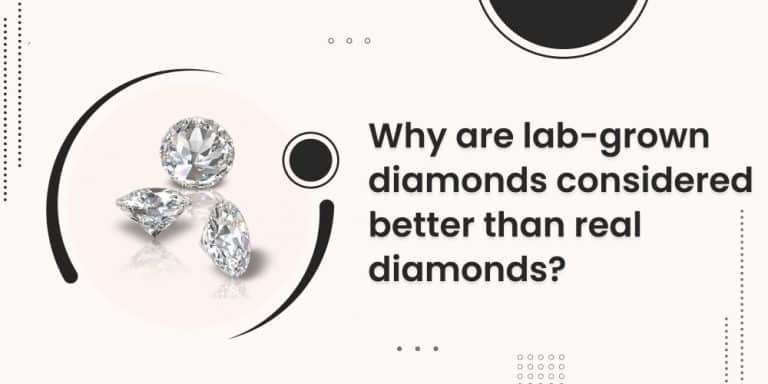When it comes to diamonds, there are so many options to choose from- mined diamonds, lab-grown diamonds, moissanite, and cubic zirconia. Though most diamonds look the same to untrained eyes, not all diamonds are the same value and feature-wise.
For those buying a diamond for the first time, there is even more confusion when various jewelers give wildly fluctuating prices for loose diamonds. For such customers, some unscrupulous jewelers go to the extent of selling diamond imitations as real ones to claim high profits. Others may give different prices for lab-grown diamonds, cubic zirconia, and moissanite diamonds which can confuse the customer further.
So, how do you know which is which? Ask the jeweler for a certificate stating the 4C (Cut, Color, Clarity, and Carat weight) characteristics of the diamond. Also, check the diamond physically under a microscope for an etched number. This confirms that the diamond is a genuine mined diamond.
So far so good. But what about lab-grown diamonds?
Some jewelers may claim that lab-grown diamonds are stronger and better than natural mined diamonds. How much of this is true? We’ll find out in this post.
Lab-Grown Diamond Vs. Real Diamond
It is impossible to tell whether a diamond is mined or lab-grown just by looking at it- even highly experienced gemologists wouldn’t be able to tell which is which without the use of specialized equipment.
If this is the case, you may think-
What Is A ‘Real’ Diamond? How Is It Different From Lab-Grown Diamonds?
Well, to start with, lab-grown diamonds are diamonds in their truest sense. They are identical to mined, natural diamonds in every way, the only difference is that they are manufactured in a lab setting. The manufacturing process for lab-grown diamonds reflects the way real diamonds form in the Earth’s crust.
Real diamonds, on the other hand, are formed naturally in the Earth’s crust over billions of years of pressure and chemical reactions. On the other hand, lab-grown diamonds are manufactured within a short time under a controlled environment.
In fact, both these types of diamonds appreciate in value so well that you can sell diamonds Denver or any other place and get an inflation-beating return on them. This is usually the case with selling diamonds for making jewelry or reselling them to others with the intention of a tidy profit.
Lab-Grown Diamonds Vs. Cubic Zirconia/Moissanite
Though lab-grown diamonds are sometimes called ‘synthetic diamonds’, there is a big difference between these and other diamond imitations like Cubic Zirconia or Moissanite.
Just as natural diamonds come from the earth and lab-grown diamonds are manufactured, moissanite is a diamond imitation that is both manufactured and occurs rarely in nature. Though these are similar to diamonds, it is a cheaper alternative to them because of its double refraction. When exposed to light, moissanite refracts light like a ‘disco ball’, while diamonds refract light only internally. This is true for both lab-grown and mined diamonds.
Cubic Zirconia (CZ) on the other hand, is a manufactured diamond imitation made of zirconium dioxide. CZ is more porous which results in yellowing over time. Lab-grown and mined diamonds remain the way they are for eternity. Their characteristics cannot be compared with simulant diamonds like manufactured moissanite or cubic zirconia.
Why Buy Lab-Grown Diamonds?
Though lab-grown diamonds have been around for quite some time now, it is only now when their popularity is booming. Though many people consider natural mined diamonds as a natural choice, cost-conscious customers are increasingly choosing lab-grown diamonds. Here is why-
Cost Difference – Lab-grown diamonds are almost 40 percent cheaper than mined diamonds. This is why many jewelers primarily pitch these diamonds to budget-conscious men who would want to get a diamond engagement ring made for their loved ones. Saving here could help them allocate more money towards their wedding reception, honeymoon, or a down payment for their house.
Ethical Considerations – Diamond mining is contributing to a lot of pollution and environmental degradation. Diamonds mined in Africa are sometimes called ‘blood diamonds’ as questionable and unethical manufacturing methods are used. This sometimes means mining illegally or using bonded labor for mining. So much so, mined diamonds have to come with a certificate stating they have been ethically sourced. Lab-grown diamonds do not come with any such controversies.
Summing Up
Lab-grown diamonds are non-controversial, brilliant, and come much cheaper than mined diamonds. The only difference lies in the fact that they are manufactured mimicking the way they were made in nature.
There is no doubt why many jewelers all across America, including Diamonds Source Jewelers, recommend them to most clients for the best results.

